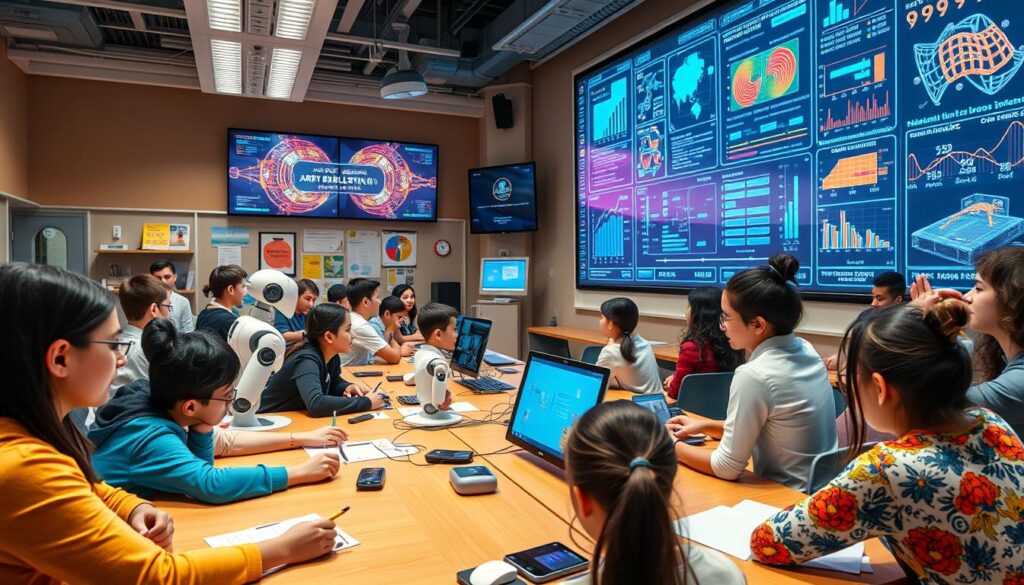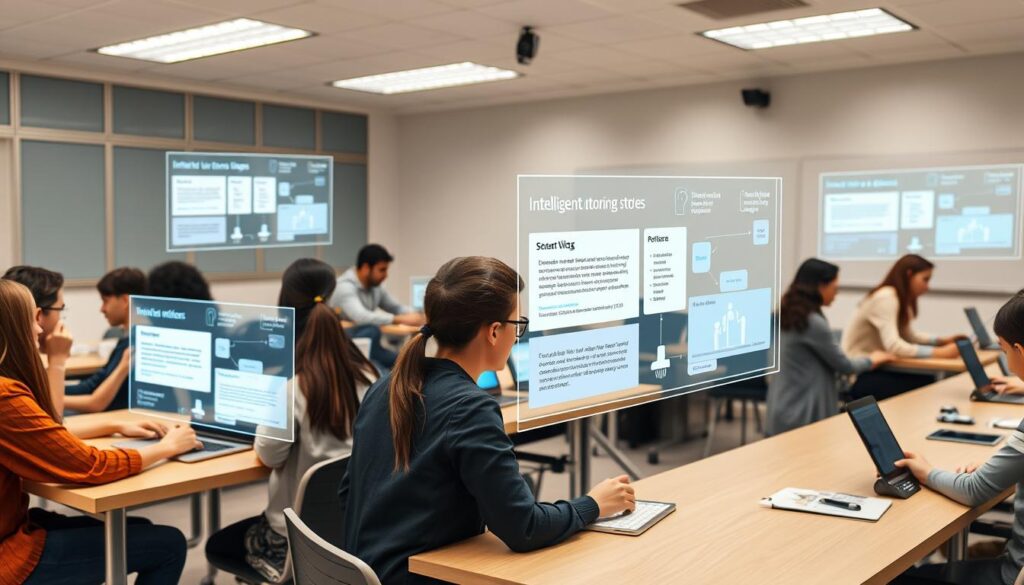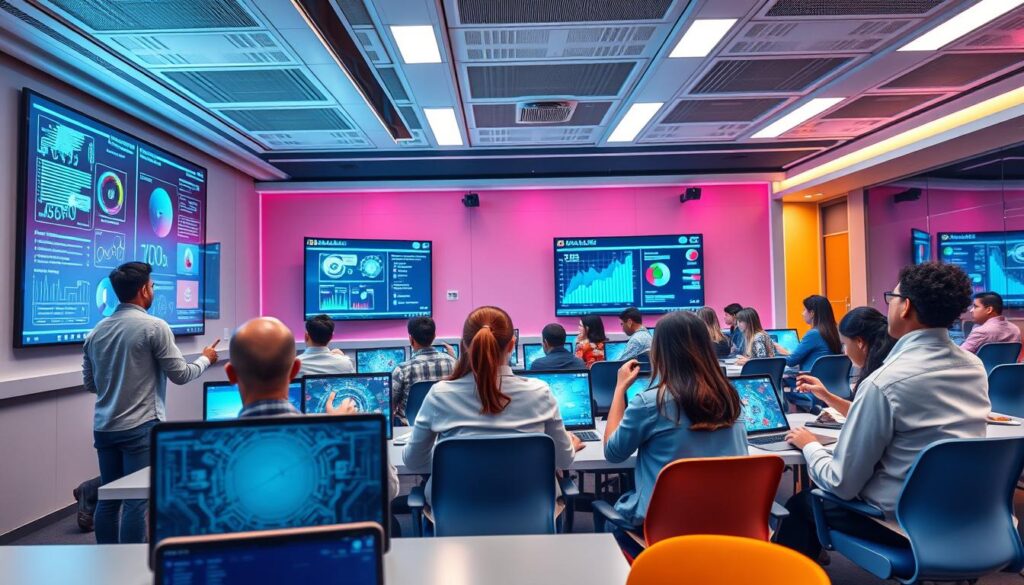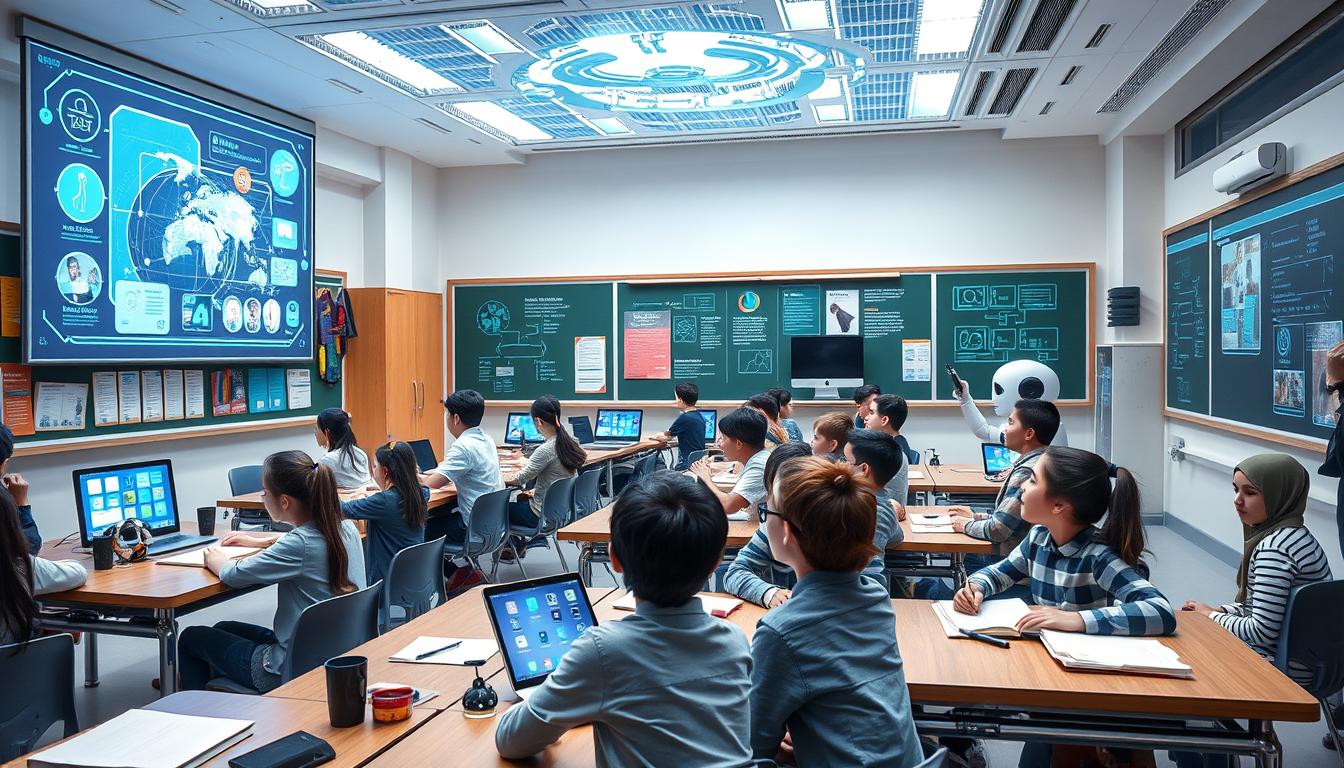Did you know that about 60% of teachers are now using AI in their classrooms? This change is just starting. Experts think the AI education market could hit a huge USD 20.54 billion by 202712.
Old teaching methods are being replaced by new tech. This tech, powered by machine learning, makes learning more personal. It promises to make learning better and more fun for students from all walks of life.
Most teachers see AI as a game-changer. But, many worry about its ethics. This shows we need to teach teachers more about AI’s good and bad sides3.
Key Takeaways
- 60% of educators utilize AI tools in their teaching processes.
- The AI education market is projected to reach USD 20.54 billion by 2027.
- Younger teachers are at the forefront of adopting AI technology.
- AI offers personalized learning, grading assistance, and tutoring capabilities.
- Concerns about academic honesty and ethical AI usage are prevalent among educators.
- AI enhances educational equity by providing high-quality instruction globally.
Understanding AI in Education
Artificial intelligence is changing education in big ways. It makes learning more personal and fun. AI helps students learn by solving problems and making decisions like humans do. It also changes what it teaches based on what each student needs.
The global market for AI in education was worth USD 1.82 billion in 2021. It’s expected to grow a lot, with a 36.0% CAGR from 2022 to 20304.
Definition of AI in the Educational Context
AI in education uses smart algorithms to make learning better. These systems look at how students do and change what they learn. They also give feedback right away to help students understand better.
AI tutoring systems are great at explaining things in detail. They give feedback and check if students get it45.
Key Technologies Behind AI
Several technologies make AI work in schools. Machine learning makes learning fit each student’s needs. Natural language processing lets AI talk to students and help them anytime they need it65.
Schools using these technologies see better grades and more interested students. It helps students get ready for the future.
The Role of Machine Learning in Schools
Machine learning is changing how we learn in schools. It makes learning better by focusing on each student’s needs. This is different from old ways of learning.
Machine Learning Vs. Traditional Learning Methods
Old learning methods try to fit everyone into one box. But, machine learning makes learning personal. It uses data to find out what each student is good at and what they need to work on.
This way, learning becomes more effective. Students do better in school. AI helps teachers by doing tasks that take up too much time, so they can teach more7.
Adaptive Learning Systems
Adaptive learning systems are a big step forward in education. They use algorithms to see how well students are doing and change what they learn. This makes learning fit each student’s pace.
These systems make learning better by making it more engaging. They help students learn on their own and fill in gaps in their knowledge8. Students get feedback right away, so they know how they’re doing. Teachers can then help each student in a way that really works for them.

Benefits of AI and Machine Learning in Classrooms
AI and machine learning bring many benefits to schools. They make learning more personal, help with paperwork, and keep students interested. These tools are changing how we teach and learn.
Personalized Learning Experiences
AI helps create learning plans that fit each student’s needs. It uses smart algorithms to adjust what and how students learn. This makes learning easier and more effective.
It also helps teachers by spotting where students might struggle. This way, teachers can help sooner and improve results9.
Improved Administrative Efficiency
Technology has made school work easier for teachers. AI helps with grading and keeping records. This frees up time for teaching and reduces mistakes9.
Teachers can focus more on teaching. This makes education better and more reliable10.
Enhanced Student Engagement
AI makes learning fun and interactive. It keeps students excited and encourages teamwork. AI tools offer quick feedback and tailored exercises, making learning better9.
This approach leads to better grades, especially for students who find school hard10.
Challenges of Implementing AI in Education
Adding AI to schools comes with big challenges. Issues like data privacy, teacher resistance, and tech problems make it hard. These obstacles need to be thoughtfully addressed.
Data Privacy Concerns
Data privacy is a big problem with AI in schools. Lots of student data is collected, raising questions about its use and safety. Schools must follow rules to keep data safe and protect students.
Resistance from Educators and Administrators
Teachers and school leaders often resist change. They fear AI might replace them and question its value in teaching. These worries make it hard to adopt AI in classrooms.
Technological Limitations
There are also tech issues to deal with. Schools often lack the right equipment and resources for AI. Teachers need training and help from experts to use AI tools well to support this transition1112.

| Challenge | Description |
|---|---|
| Data Privacy | Concerns arise over the collection and usage of student data. |
| Resistance to Change | Educators fear loss of traditional roles and may doubt AI’s effectiveness. |
| Technological Limitations | Inadequate infrastructure and limited access create barriers to AI implementation. |
Real-World Applications of AI in Schools
Artificial intelligence is changing education in big ways. It brings tools like intelligent tutoring systems to the forefront. These systems offer learning plans made just for each student. They help students understand math and languages better and feel supported.
Intelligent Tutoring Systems
Intelligent tutoring systems use smart algorithms to adjust learning based on how students interact. For instance, Thinkster Math combines AI with human help to create learning paths that really work. This makes learning math and other tough subjects more engaging and effective13.
Also, some universities use AI tools like Jill Watson to help with communication. This tool makes it easier for students and teachers to talk and work together13.
AI-Driven Assessment Tools
AI assessment tools are also making a big impact. They quickly check student work and give feedback right away. This helps students see how they’re doing and what they need to work on14.
Tools like these use data mining to help teachers tailor lessons for each student. This makes learning more inclusive and helps all students succeed14.

The Future of Education Technology
You’re on the edge of a new era in education technology. AI innovations will change how we learn and teach. AI tools are becoming key in schools. For instance, ChatGPT’s popularity in 2023 shows the exciting changes ahead15.
Innovations on the Horizon
Soon, we’ll see more immersive tech like augmented and virtual reality. These will bring learning to life in new ways. By 2024, they’ll be big in schools, changing education forever15.
Gamification will also grow, making learning fun. It will add interactive parts to lessons, making them exciting.
The Potential of AI to Transform Learning Environments
AI can make learning more personal for each student. Schools will use tech data to help students overcome challenges. This will make learning paths more tailored15.
But, there are also risks like cyberattacks. Schools must stay safe while using new tech15. Teachers will need to teach students about AI, helping them understand and use it wisely15.

Training Educators to Use AI Effectively
Using AI in schools needs a big push in training educators. They must learn how to use this tech well. Over the last five years, teachers have been working with new tech, like AI, in their classrooms16.
Programs for Professional Development
Many professional development programs help teachers get ready for AI. Places like ISTE, AI4ALL, Google AI Education, and Microsoft offer courses. These teach AI and machine learning for schools16.
ISTE’s AI in Education Preparation Program has seven strategies. They focus on making sure all teachers know about AI17. Online groups, webinars, and events like the AI Infused Classroom Summit also help teachers learn about AI16.
Building Digital Literacy Among Teachers
Teaching AI also means teaching digital skills. It’s important to talk about AI’s fairness and ethics in teacher training17. Schools need a plan that covers tech, curriculum, and support for AI in classrooms18.
Teachers need to know how to check if AI tools are fair and right. This helps use AI in a good way in schools18.

Keeping up with AI in schools is key. Think about how to improve your training programs. Check out this guide for tips on teaching AI literacy16.
Measuring the Impact of AI on Student Outcomes
To see how AI affects learning, we need to look at certain numbers. These numbers show how well AI works in schools. They include things like how well students do in school, how much they participate, and how many stay in school.
Metrics for Success
Success in AI education is measured in many ways:
- Academic Performance: AI helps make learning fit each student’s needs. This can lead to higher grades19.
- Engagement Levels: AI tools give students help that’s just for them. This makes them understand and feel more confident, which helps them stay interested19.
- Retention Rates: AI changes quiz levels based on how well students do. This makes learning more personal and helps students remember more19.
Case Studies and Real-World Examples
Many schools have shown how AI can really help. Studies of 63 AI-STEM research papers found a clear link between AI and better learning in math and language20. For example, DreamBox Learning adjusts its challenges to fit each student’s level. This makes learning better for everyone19.
Teachers say they see big improvements in how well students do and how happy they are.
Conclusion: Embracing AI in Your Educational Journey
AI is changing how we learn in schools. It makes learning more personal and helps teachers teach better. Schools can improve by training on AI tools and updating their lessons.
Working together, teachers and tech can boost student success. Studies show students can learn up to 30% more in some subjects21. They also see better grades and are happier21.
Steps for Educators and Institutions
Start by looking into AI training for teachers. Using AI tools helps track student progress and tailor lessons. It’s also important to find platforms for instant feedback and growth22.
Resources for Further Exploration
There are many resources to learn more. Websites and platforms share AI tips and success stories. Joining professional groups can connect you with new ideas and examples23.
By using AI, we can make education fairer for everyone23. Check out this study for more on AI’s impact in schools.
FAQ
What is AI in education?
How does machine learning differ from traditional learning methods?
What are intelligent tutoring systems?
What challenges exist when implementing AI in schools?
How can AI enhance student engagement?
What role does educational data mining play in AI in education?
What are the benefits of AI in administrative tasks?
What future innovations can we expect from AI in education?
How important is educator training in using AI technologies?
How can we measure the success of AI applications in education?
Source Links
- Artificial Intelligence In Education: Teachers’ Opinions On AI In The Classroom – https://www.forbes.com/advisor/education/it-and-tech/artificial-intelligence-in-school/
- The Role of AI in Shaping the Future of Education Industry – https://www.bytestechnolab.com/blog/role-of-ai-in-education-industry-future/
- The Ultimate Guide to AI in Education: Benefits, Challenges, & Real-World Uses (2024) – https://www.powerschool.com/blog/ai-in-education/
- Research Guides: Artificial Intelligence (AI) in Education: Home – https://guides.lib.jmu.edu/AI-in-education
- Learning With AI, Learning About AI – https://www.cde.ca.gov/ci/pl/aiincalifornia.asp
- AI in education: Use cases, solution and implementation – https://www.leewayhertz.com/ai-use-cases-in-education/
- The role of AI in modern education – https://onlineprograms.education.uiowa.edu/blog/role-of-ai-in-modern-education
- Machine Learning in Education- Cloud Services for Education- AWS – https://aws.amazon.com/education/ml-in-education/
- Machine Learning in Education: Benefits and Opportunities – https://intellias.com/benefits-of-machine-learning-in-education/
- Can AI transform education? – https://www.gatesfoundation.org/ideas/articles/ai-tools-education-technology
- Artificial intelligence in education: Addressing ethical challenges in K-12 settings – https://www.ncbi.nlm.nih.gov/pmc/articles/PMC8455229/
- Incorporating Artificial Intelligence Into The Classroom: An Examination Of Benefits, Challenges, And Best Practices – https://elearningindustry.com/incorporating-artificial-intelligence-into-classroom-examination-benefits-challenges-and-best-practices
- 43 Examples of Artificial Intelligence in Education – https://onlinedegrees.sandiego.edu/artificial-intelligence-education/
- How Is AI Used In Education — Real World Examples Of Today And A Peek Into The Future | Bernard Marr – https://bernardmarr.com/how-is-ai-used-in-education-real-world-examples-of-today-and-a-peek-into-the-future/
- How technology is reinventing K-12 education – https://news.stanford.edu/stories/2024/02/technology-in-education
- Effective Professional Development on AI – https://www.edutopia.org/article/ai-professional-development-helps-teachers-tech-integration/
- 7 Strategies to Prepare Educators to Teach With AI – https://www.edweek.org/technology/7-strategies-to-prepare-educators-to-teach-with-ai/2023/06
- Demystifying Artificial Intelligence (AI) for K-12 | All4Ed – https://all4ed.org/future-ready-schools/emerging-practices-guides/demystifying-artificial-intelligence-ai-for-k-12/
- Transforming Education: The Impact of AI on Educational Technology – https://www.rapidinnovation.io/post/how-ai-is-transforming-the-educational-technology-industry
- The application of AI technologies in STEM education: a systematic review from 2011 to 2021 – International Journal of STEM Education – https://stemeducationjournal.springeropen.com/articles/10.1186/s40594-022-00377-5
- AI in Education: Transforming the Education Sector – https://hashstudioz.com/blog/ai-transforming-education-sector/
- How is AI impacting the education system? – https://keymakr.com/blog/how-ai-is-impacting-on-the-education-system/
- The Importance of AI in Education: Transforming Learning and Teaching – https://www.suraasa.com/blog/importance-of-ai-in-education



